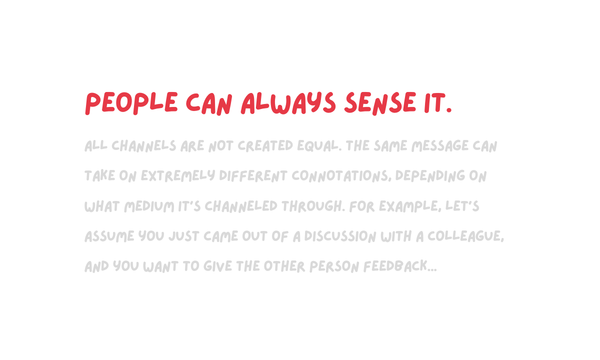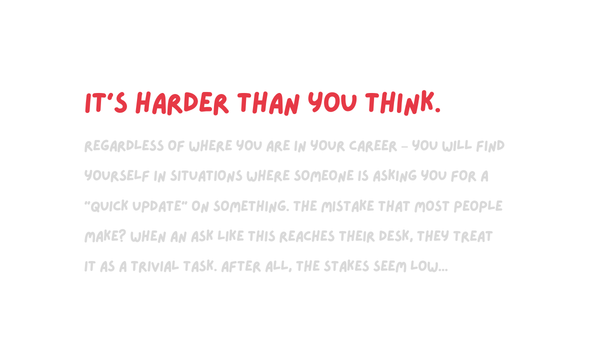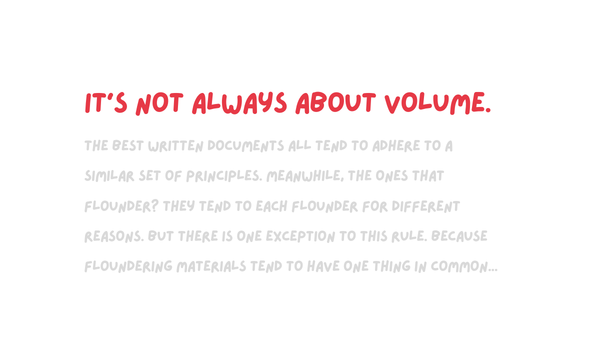✍️ 10 Bad Writing Habits Holding You Back

If you were a good writer in school – it might be backfiring on you at work.
Because here's what I found: in order to get your message across at work, sometimes you have to "un-learn" the writing habits learned in school.
And in some instances – we need to do the exact opposite.
So if you're looking to write in a more impactful way at work: go through this list and see which ones are holding you back.
(And if you weren't a good writer in school, you definitely don't want to skip this!)
📑 Table of Contents:
Bad Habit #1: Writing Non-Controversial Statements.
Here's my favorite litmus test when I review a document (whether myself or someone else's). I look at the key statements, and I ask myself:
"Who would actually disagree with this?"
Sure, it's one thing to set context or establish facts (absolutely nothing wrong with that). But it's another thing to write statements that provide no point of view (and therefore little value as well).
Here are some examples of what I consider low-value-add statements. They all share one thing in common, which is that they all should generate an "uh, of course" reaction from you (and maybe an eyeroll):
- Collaboration across cross-functional teams is the key to success.
- We will focus on helping our customers make the best of our products
- A thoughtful and collaborative approach will be taken to analyze this issue
Every word, statement, paragraph, and section should serve a purpose. Sometimes you need to state the obvious. But 100% of the time you are paid to deliver a point of view (and to back up that point of view with facts).
And the more real estate you dedicate to "non-controversial" statements, the more it is a waste of time for your audience (and a missed opportunity to influence them).
Bad Habit #2: Not Sign-Posting.
In order for your content to travel far within the organization without losing fidelity, you need to do some dummy-proofing, to make sure that even someone with little context (especially without your voiceover) can still interpret it properly.
Or at the very least, have the patience to finish reading your work.
This is where sign-posting becomes incredibly useful. Don't just assume that people will read your document and interpret it with the same lens. Instead, tell people upfront how they should interpret it.
If you don't signpost well, situations like these can happen:
- You wrote down the challenges you're facing (in order to seek support). Yet your reader assumes that you're just surfacing for visibility. This could've been avoided if the section was simply labeled as Where We Need Help.
- You wrote down many hypotheses in order to generate reactions from your stakeholders. Yet it generated allergic reactions, as if you jumped to conclusions already without the facts. This could be easily avoided with a one-sentence caveat upfront.
- You used a couple bullet points to provide context to an issue before explaining the problem statement. Yet without sign-posting your bullet points with "context," your audience lost interest and patience and never got to the problem statements.
The guiding principle is this: you never want your reader to feel unsure about what lens they should be applying to a given section of your content.
Your audience also shouldn't wonder how each section or paragraph connects to the preceding one. Something as simple as "Now that we've surfaced the pros and cons, we'll review the options on the table and propose a solution" can help make the reading experience so much smoother for your reader.
In short, don't assume. When in doubt, sign-post.
👋 Subscribe for free to get Herng's newsletter directly in your inbox.
Bad Habit #3: Not Being Specific Enough.
Specificity is usually the northstar when it comes to business writing. As is brevity. To do that well, you need incredible precision when it comes to language.
However, it is very easy to fall into the trap of using generic verbiage that leaves your readers confused at best, and misinterpreting your message at worst.
Here's an example:
- Operational rigour in the sales org has not been perfect and has room for improvement. We want to work closely with the leadership teams to devise a plan to course-correct.
This is not a terrible bullet point – it has enough legs to stand on its own, although you could argue that it applies to a very wide spectrum of situations. The statement could describe everything from a C- to a B+ sales org.
To optimize for specificity (and actionability for problem-solving later on), this is a much more specific (and better) framing:
- Context: Operational rigour* in the sales org is underperforming regional and global counterparts by 20~30%. This has persisted for the last two quarters, and soft reminders have not worked.
- Ask: This document intends to seek executive support for 3 proposed initiatives to bring operational rigour back to regional parity.
* as measured by client interaction frequencies and pipeline robustness.
Specificity doesn't always require long sentences and chunky sections. But you have to work fairly hard to strike that perfect balance.
And it's worth it.
Bad Habit #4: Using Overly Complex Words
Here's the paradox: all our lives we've been asked to learn (and use) big, smart-sounding words.
But then BOOM. All of a sudden, at some point during our careers, we realize that doing so is detrimental – um, I mean, counterproductive – to what we want to achieve.
When it comes to verbiage, the opposite of complexity is not simple or basic. It's straightforwardness and precision.
Because if we don't challenge ourselves to do so: we simply run the risk of somebody misinterpreting what we mean. We also run the risk of people instinctively assuming we're simply spewing generic platitudes.
As a result, good business writers don't try to show off how smart they are by overusing complex words. Instead, they focus on getting their point across clearly via a precise command of language.
❌ So instead of saying: “We’ll drive synergistic efforts and deep collaboration as a result of org rebalancing.”
✅ They'll say: “We expect partner coverage to improve by 10~15% due to the re-org.”
❌ And instead of saying: "This workstream is not germane to our problem statement."
✅ They'll say: "This workstream is a distraction."
(Oh and look at that – I'm signposting with ✅ and ❌.)
Bad Habit #5: Not Thinking in Buckets or Tables.
Good writing at work often relies on structure. There are three things that can be incredibly helpful for both the writer and the reader:
✅ Thinking in Buckets
It is helpful to compartmentalize and organize our thoughts as much as possible. It's very hard for anyone to follow along if you have 8 seemingly independent sub-sections to talk through.
Much easier for the reader to follow along if you simply have 3 big buckets, and each with 2 to 3 sub-issues.
Side note: most good things come in threes. If you can push yourself to compartmentalize your thoughts into relatively MECE sets of three, you will become a much more effective communicator (both on paper and in person).
✅ Using Tables (Literally)
A business document does not have to be only text. The best ones I've seen employ a mix of prose and tables when needed.
For example, sometimes when I review strategy documents that are verbose yet unclear, I simply ask the authors to put it in a table that shows what actions they plan to drive with what clients.
Boring? Of course.
Effective? You bet.
✅ Using Tables (Mentally)
Of course, you don't always have to use tables. But you should have rows and columns as part of your mental model. This forces you to simplify issues down into two primary dimensions, and can help you tune out the noise.
(Note to the wise: this often turns into a two-by-two matrix, which can be incredibly helpful to simplify issues and help with communication.)
Even if your final output resembles prose, you will now have a much clearer way to articulate the issue, and your readers can follow along much more easily. Win win.
Bad Habit #6: Using "We" Loosely.
One thing that I have found myself asking more often than I'd like at work is this:
Who do you mean when you say "we?"
People tend to use "we" much more loosely in writing. This is a symptom of lazy thinking, as there is no attempt to articular ownership and actionability. For instance, consider the following statements:
- "We need to double down on sales growth this year."
- "We need to make our products more competitive."
- "We need to reimagine our internal resourcing model."
These may all be perfectly valid statements – and you can imagine them all appearing in the same document – but the we in each statement all point to different people/teams.
Therefore, it might be more productive to write in the following manner:
- "We need to double-down on sales growth this year by working with sales leadership and finance to redesign sales incentives."
- "We need to make our products more competitive by making an explicit ask to the Product org to invest engineering resources in our markets."
- "We need to reimagine our internal resourcing model. Propose that the strategy and finance teams review the current model and deliver a proposal that optimizes for cost efficacy."
Your "we" isn't always my "we." You don't always have to spell it out, but business writing is about actionability and ownership, and you want to always push yourself to be crystal clear about who exactly it lies with.
Bad Habit #7: Not Writing in Digestible Chunks.
Writing isn't hard. You just dump your thoughts on a piece of paper.
Writing well is hard. Because you are doing everything you can to make it easy for your reader to digest.
But sometimes when you're in the zone, it's hard not to let your thoughts just flow. And before you know it, you end up with incredibly chunky paragraphs.
That makes life for your reader very hard.
On the other hand, you can't just rely on one-liners.
Like I'm doing right now.
Sure it's easier to read.
But everything is disjointed.
What you want to do instead is to strike the right balance. Find that sweet spot where each paragraph is self-contained and meaty. And make sure you have the right logic so the ensuing paragraph flows naturally.
This will require lots of editing and re-editing. But your end product will be so good for your reader.
Bad Habit #8: Overusing Hyperbole.
No one has voluntarily sat down to write a business document on how mediocre and average their business is.
I get that.
But when every document you read boasts of above-market growth, best-in-class execution, unbelievable results...
You end up questioning the credibility of the material (and start preparing a bucket of salt).
I’m not saying to forget storytelling principles. Not at all. But I am saying that there is a meta-game to business writing. It requires a strategy in and of itself.
Whether you’re writing a story, a briefing note, a business case... it is ultimately a collection of building blocks.
And if all the building blocks are HIGH – nothing is really HIGH.
And if all the building blocks come with nuances and caveats: well, no one would ever finish reading.
So think of whatever you’re writing as a portfolio of statements. Be nuanced when you have to. Be punchy and apply some hyperbole when you need to.
But it can’t be for every single thing. You’ll lose the reader’s trust quickly.
Bad Habit #9: Neglecting to Contextualize.
Most people forget that not everyone reading their writing is from their world.
They assume everyone knows their acronyms. OK, easy fix.
But they also assume everyone knows whether 10% growth should be considered amazing or mediocre.
If you don't need your writing to travel far, and /or everybody has shared context: great. But if you want your writing to resonate; challenge yourself to contextualize.
So don’t just say: “This investment will help us grow X metric by Y%.”
✅ Say also: “It will effectively pull forward our product roadmap by 3 years.”
(For practical tips on how to properly contextualize, read the post below.)

Bad Habit #10: Not Selling Anything.
If you're writing at work, you're probably trying to make something happen. Therefore, you should always be selling the audience something. For instance:
- It can be an ask for resources
- It can be a narrative intended to mythbust
- It can be a (seemingly) neutral update, but to lay the groundwork for a future pitch
Whatever it is, you always want a call-to-action. Even if it’s subtle. Having clarity over "what you're selling" ensures that all the pieces of your content will jive with one another.
You don't want to be in a situation where one part of your document suggests the house is on fire, while another part brushes over it with no sense of urgency.
Before you write, you need to have decided already what action (or reaction) you're trying to get from your reader, which then dictates the tone you take, the evidence you surface, the depth you go into...and so on and so forth.
I’m not saying that you can’t have documents dedicated to pure updates or education. But even then, you're still trying to influence people's thinking one way or another. There is always an implied message behind the message.
So whenever you write, ask yourself who you're trying to influence, and what you want from them.
(And if there’s absolutely no call-to-action, you better make sure it’s a damn insightful update.)



